Fundraising letters communicate your organization’s needs, give your recipients information about how they can help, and ask them to get involved. This type of fundraising letter is an optimal chance to share your story, show donors the impact they can make with a gift, and gain support for your mission.
Explore how you can best use fundraising letters by using the navigation below:
- How to write a fundraising letter
- Fundraising letter examples
- How to write a fundraising email
- How to write a donation acknowledgment letter
- How to use AI to generate fundraising letters
Fundraising letter templates
Continue reading to learn the basics behind writing a fundraising letter and how you can get started. Or, if you’d rather go straight to our templates, use the list below to quickly jump to the fundraising letter you need:
How to write a fundraising letter
As you explore how to write a great fundraising letter, it’s important to follow a few key steps to write the most compelling and effective letter possible. These steps include:
1. Address your recipient personally.
By addressing your recipient by name, they won’t feel like they’re just one of many reading this letter. Be sure to personalize your outreach with names so each reader knows you value their individual support.
2. Tell a story.
Show your reader the issue or problem your organization’s working to address with a story. Give details about the people you’re trying to help so it’s clear how they can benefit from a donation.
3. Define the problem.
Clearly outline the larger issues and problems your clients are facing. Be as straightforward as possible when doing this.
4. Explain your mission and outline your goal.
Explain your need and how it fits into your overall mission. Your readers should understand how their donations will be used and who will benefit from them. Make sure to clearly explain the impact of the donor’s gift and how it will make a difference.
5. Explain how your donor can make an impact.
Before donors give, they want to know exactly how their donation will make a difference in the world. You’ve already defined a problem for them; explain how their donation will solve the problem with specific actions. For example, if you’re raising money for an animal shelter, you can specify that a donation of $50 will provide food for X number of pets!
6. Call the reader to action.
Explain the urgency of the situation so you can convince your readers to act quickly. Mention what your other donors’ gifts have already done to address the problem and note the progress your current fundraiser is making.
In addition to following these steps, be sure to focus on the “you” and “we” language in your letter, but mostly focus on the “you.” Your outreach should be about your reader and the impact they can make, and it should directly appeal to them. Using “you” and “we” language is important and helps provide a touch of human interest to your fundraising letter.
Fundraising letter FAQs
How long should a fundraising letter be?
A fundraising letter should be concise. One page is a great length, but some stories take a little longer to tell. A good rule of thumb is to use exactly as many words as it takes to define the problem and ask donors to provide a solution—nothing more! You may also include extra materials (such as information about matching gifts, additional details about your organization, etc.) or additional lift pieces to your appeal. If you decide to make your fundraising letter longer than one page, be sure donors know what actions you want them to take by the end of the first page.
How should you send a fundraising letter?
Fundraising letters can be sent through a variety of channels, though the more effective ones tend to be via email and direct mail. To personalize your outreach, make sure your fundraising letters are addressed to a specific individual, which is accomplished easily through email and direct mail. Don’t just write “Dear Donor” instead!
Why are fundraising letters important?
Fundraising letters are important because they give you an opportunity to demonstrate your financial needs, get donors involved with your cause, tell your emotional story, show donors why their gifts are important, and create a long-term relationship with your supporter.
Fundraising letter examples
To get you started with your drafting, we’ve written some fundraising letter examples for different scenarios surrounding different types of campaigns.
Standard fundraising letter
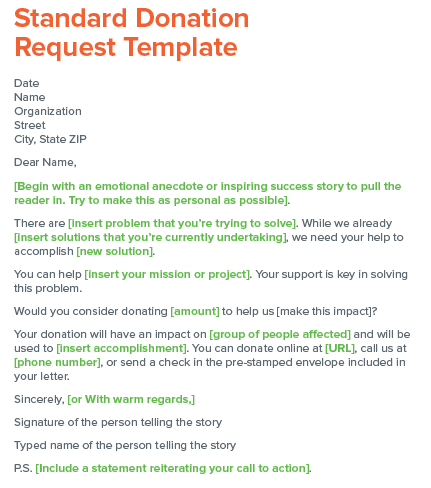
If you’re asking for donations, you need to have a standard format that can be used as a baseline for all of your other fundraising letters. This letter should be:
- Donor-centric
- Personalized
- Concise
This template is generic, but your fundraising letters should be segmented depending on your relationship with the recipient. First-time donors should receive different letters than major gift donors, one-time donors should get different letters than recurring donors, and so forth.
This letter is quite short and gets right to the point of asking for a donation. Your letter will obviously be more specific and detailed depending on your mission and the projects your campaign will fund. You should also add a P.S. message. Here’s why: most readers absorb a letter in a specific order. The order is as follows: donors read the salutation first, then the P.S. message, and then the body of the letter. Since the P.S. is the second thing they read, it’s important that you use it to make an impact. It’s the perfect place to reiterate your call to action (where you ask people to give, volunteer, or whatever else you want them to do).
Be sure to also include a pre-addressed and stamped envelope to make it easy for your readers to give!
Individual sponsorship letter
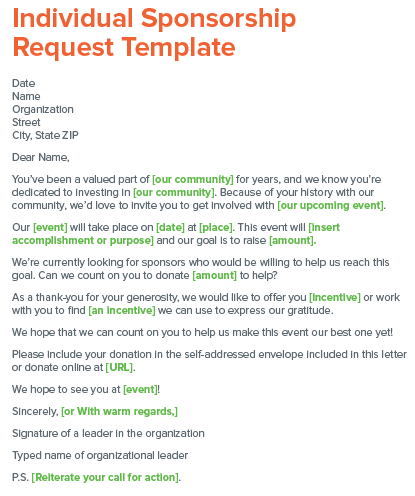
Sponsorship letters are similar to standard fundraising letters. The only difference is that sponsorships are usually tied to events like marathons, walk-a-thons, and fun runs.
The request for sponsorship might also have a reward or incentive attached, such as:
- The sponsor’s name included in promotional items and advertising materials.
- Certain merchandise related to the event.
- Seats or tickets to the event.
If you really want to make an impression on potential sponsors, ask them what incentives they’d like before sending the appeal. They may have ideas you’ve never considered!
As with the standard fundraising template, this sponsorship request template can be tailored to fit your organization’s needs. You should always include more information about the event itself and what sponsors will receive in exchange for their donations. Remember to keep this donor-centric, especially if the recipient has sponsored your event or supported you in other ways in the past. If they have supported you in the past, make sure to reference that early gift and thank them for their past involvement.
Volunteer request letter
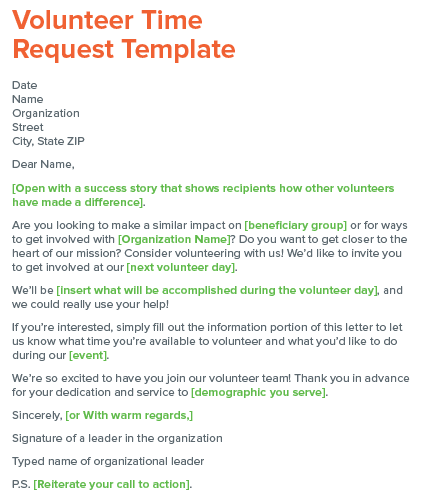
A volunteer request letter should focus on the work that a volunteer might do should they choose to work with your organization. It should also let them know how their work will positively impact the people or community you support.
Volunteers are often more familiar with your organization if they’ve been involved in the past. If you’re writing a letter to someone that you know has a history of volunteering with your organization or other nonprofits, you should reference that involvement and thank them for their service.
Corporate sponsorship letter
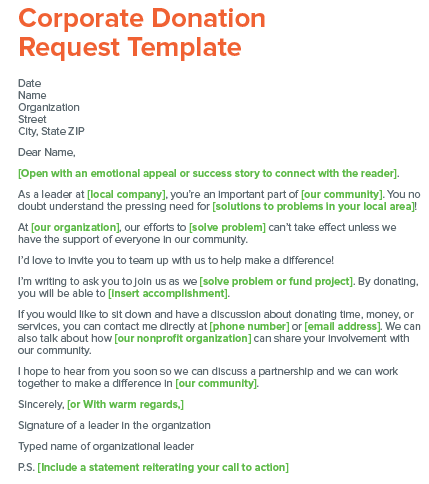
Note that this letter asks for an in-person meeting with the leader of the organization. The company to which you’re writing may be hesitant to give money to a nonprofit they’ve never worked with before. In-person meetings are a good move even with organizations that have supported you in the past; most major donors prefer to handle their philanthropic conversations in person. That includes corporations and other businesses!
An in-person meeting can greatly help your fundraising efforts. It allows the business leader to ask questions, express concerns, and become more familiar with your organization—and with you! Donors prefer to give to people rather than organizations, even if they’re part of a big company. Your face-to-face meeting will make them much more likely to give
Again, this letter can be modified to suit your organization’s mission and needs.
Peer-to-peer fundraising letter
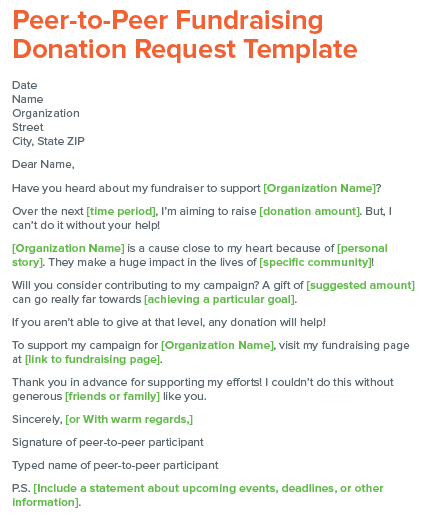
Peer-to-peer fundraising campaigns are one of the most effective ways for your nonprofit to raise money and spread the word about your mission online. Your supporters will launch personalized fundraising pages on behalf of your cause, then reach out to their personal networks to solicit gifts from friends, family, and coworkers.
To give your peer-to-peer fundraising participants an idea of how to solicit these gifts, offer them a template like this one. By filling in the blanks, they can easily craft effective and personalized solicitations.
When your participants sign up and start designing their fundraising page, consider providing fundraising templates like this one to help them get started. If you’re using Qgiv, these are easy to create! You can include them in your participants’ fundraising dashboards, which will give them instant access to the email section of their sharing tools.
Matching gift fundraising letter
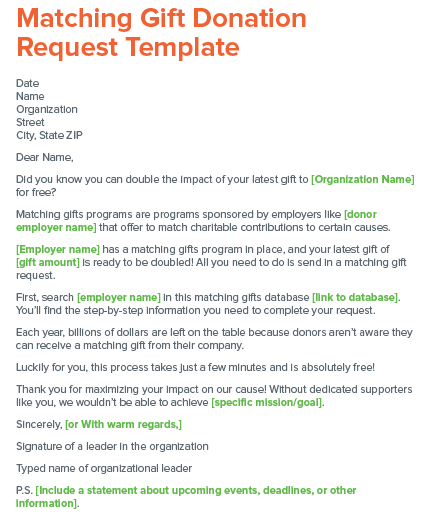
It’s rare for all of your supporters to know what matching gifts programs are, much less if their employers offer matching gifts. This is why your nonprofit should plan to send matching gift fundraising letters with supplemental information to recent donors. These letters can outline how to check eligibility and send in a matching gift request to complete the process.
As you prepare to send your letters, use a matching gift database to determine which of your donors qualify for a matching gift. Then, create a donor segment list in your CRM of these special supporters.
Additionally, be sure to highlight the fact that submitting this request will not require any further giving on their part. Submitting this request is the best way for them to maximize the impact of their original gift and is essentially free money for your cause.
School fundraising letter
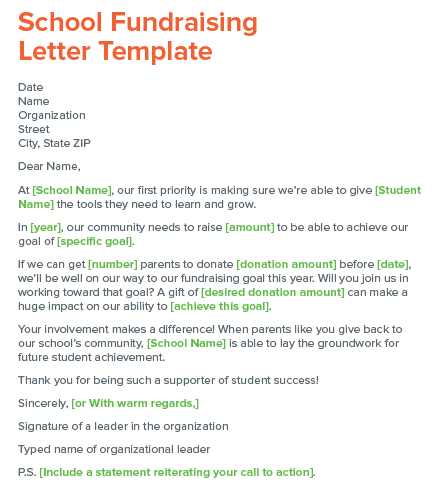
Schools are among the most common nonprofit organizations out there, and they generally have an incredibly wide range of constituents. This is why it’s so important that schools take their fundraising needs seriously and plan ahead for how they’ll request donations from community members.
To make your school’s fundraising efforts more effective, create templates for different kinds of donation letters based on the type of supporter you’re addressing. Perhaps you’re soliciting a gift from a parent of a current student; address them accordingly! Alternatively, you might want to draft a template of a solicitation addressed to an alumnus.
When creating your school fundraising letter template, your nonprofit should emphasize the impact your school has on its current students and the next generation of your community.
Church fundraising letter
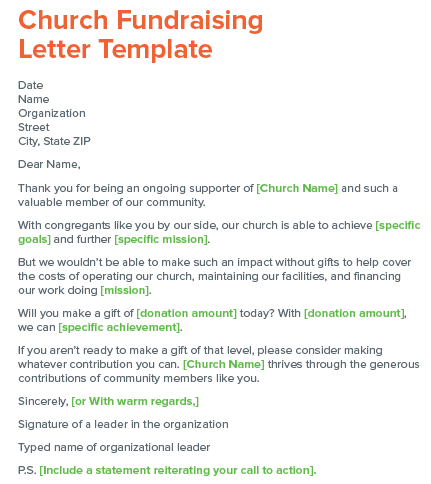
In your church fundraising letters, be sure to put your congregation’s mission first and foremost. You’ll want to immediately address your congregant’s sense of commitment to your church and make the most out of the existing relationship with this individual.
Your reader may already make collection plate gifts each Sunday, so you’ll need to make the case for them to make a more targeted gift outside of these offerings. Be sure to tell them exactly how much you need to raise and how that funding will be put to work.
Always be wary of asking your community for gifts too frequently. One strategy to minimize the risk of over-asking for contributions is to switch off between fundraising groups. For example, in February you might send letters to older congregants asking for Valentine’s Day-related contributions, while in June you could contact parents of children in your church and ask for a gift to celebrate their kids’ summer vacation.
Animal rescue fundraising letter
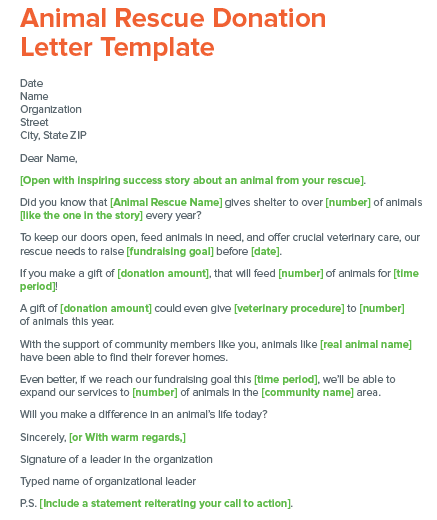
Animal rescue organizations serve an important role in your community, and you can share the importance of your work when writing a fundraising letter. Additionally, you can tap into your readers’ emotional connection to animals to make the case for why they should give back.
In your letter, show supporters how their contributions will benefit specific animals. Personify the pets that you rescue and illustrate for your readers the massive impact they can make in an animal’s life if they decide to donate. In your letter, consider sharing an image of real-life animals saved by your rescue. Include a caption with the pet’s name and age as an added way to pull at your supporters’ heartstrings. After they donate, send a thank-you letter with a follow up on these pets to emphasize the impact of their donation.
Your animal rescue should also send tailored letters to different groups in your community. These could include individuals who adopted pets from your rescue, volunteers, or helpful members of the community who have dropped off lost or stray animals at your shelter.
Auction item request letter
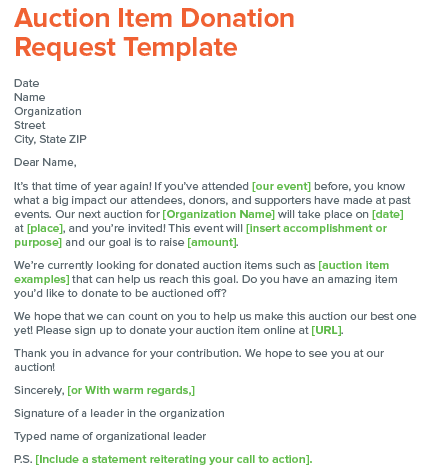
Auctions are great opportunities to raise significant funds for your organization, but procuring auction items can be tricky. Your goal should be to procure items that are appealing and will encourage your attendees to bid. Be sure to share the types of auction items or experiences you’re looking for so donors understand what you need.
You can send these fundraising letters to local businesses as well as other supporters of your organization and explain what the proceeds will go toward. Offer a compelling reason as to why they should contribute an item and make it clear who it will benefit.
How to write a fundraising email
As mentioned earlier, email is an excellent channel through which you can send donation requests. The best part? All of the fundraising letter examples we’ve provided above can be easily shared via email!
However, when it comes to writing a fundraising email, it’s important to choose fundraising software that integrates with marketing tools. This will make it easy to segment your recipients and personalize your outreach without too much effort on your end.
Consider the following when writing a fundraising email:
1. Organize your database.
By segmenting your donors and tailoring your email marketing toward different groups, you’ll be more likely to retain more donors and increase donations. Providing relevant content to the appropriate segments can make a huge difference!
2. Automate your outreach.
Using email marketing tools, you can automate your emails to be sent out on a set schedule so that you can regularly connect with supporters.
3. Use mail merge tools.
Use mail merge tools to send personalized emails to your constituents, automatically inserting their preferred names into the corresponding fields.
4. Guide recipients to your online forms.
Since emails are digital, you can customize your messages to drive traffic to your online giving forms. Call readers to action and make it easy for them to navigate to the form and give.
Making sure your fundraising software works with email marketing tools is essential because it makes tracking donations and communicating with donors even easier. Fundraising emails are simple to organize and send, so be sure to leverage these tools to create the most effective outreach possible!
How to write a donation acknowledgment letter
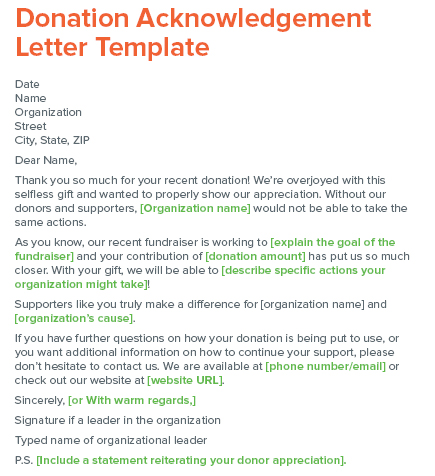
If your initial fundraising letter is successful and a supporter gives to your cause or participates in an event, it’s imperative that you show your appreciation with a donation acknowledgment letter. Without your donors, your organization would not be able to develop important programs and fund life changing projects that impact your cause.
Sending out donation acknowledgment letters does more than just thank your supporters! It also helps promote a healthy and positive relationship between your organization and donors, setting up a solid foundation for future engagement. Remember to send your letter soon after the donation is made so the engagement is fresh in the donor’s mind.
A simple thank you letter also can encourage donors to give again, increasing your donor retention rates. When a donor gives a second time, it is often called the “golden donation.” According to the Fundraising Effectiveness Report, only 19% of new donors will give again. But once that donor completes the “golden donation,” 63% will give again, increasing their chance of becoming a lifelong giver.
When writing your donation acknowledgment letter, keep in mind the same guidelines from your fundraising letter. Remember to be donor-centric, personalized, and concise! Use their first name and even include specific donation details.
You can easily convert this template to an email form as well. To maximize the impact of donor acknowledgment emails, your fundraising software should integrate with your marketing and communications tool. This way, you can automate the process. As soon as supporters make their gift, your marketing tool will send out a thank you email personalized to that donor.
How to use AI to generate fundraising letters
Need a fast way to get first drafts started for fundraising letters that don’t appear in this blog post? Using artificial intelligence programs like ChatGPT can be beneficial to your nonprofit organization. These programs comb the internet for answers to your typed prompts then write the first draft of your letters for you.
AI may not be able to match your organization’s voice and tone perfectly, but it provides a great head start toward writing a polished and effective letter to your supporters.
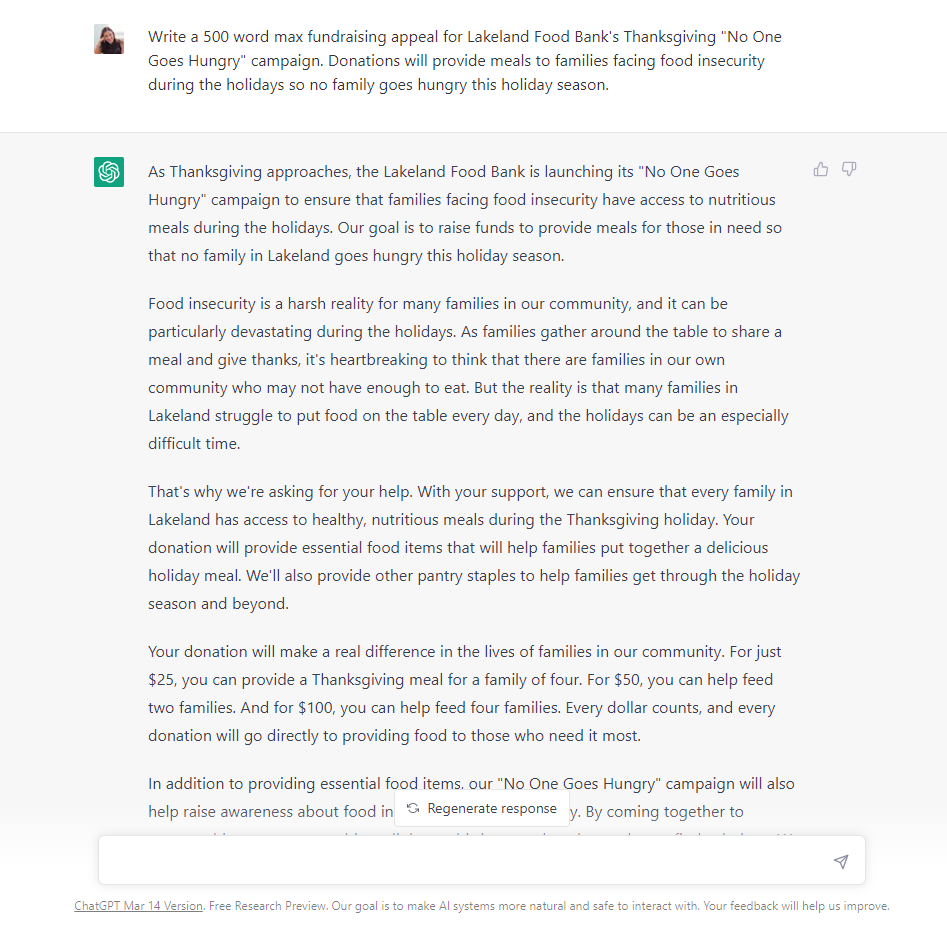
For example, the prompt above was created in ChatGPT and resulted in a 500-word fundraising appeal for a specific campaign for Lakeland Food Bank, an example nonprofit organization we created at Qgiv for testing purposes.
ChatGPT can also be used to generate thank you letters to express your gratitude. Like the fundraising appeal, it may not get your voice and tone exactly right on the first try, so be sure to edit the results you receive before sending them out. But by using ChatGPT prompts you can save a ton of time in creating email and print appeals and thank-yous to send to your supporters.
Want to make using ChatGPT easier for your nonprofit? Use the prompt template below to help you get started producing fundraising appeal and thank you letters using ChatGPT.
Write a [Word Count] word max fundraising appeal for [Nonprofit Organization Name]’s fundraising appeal, [Fundraising Campaign Name] campaign. Donations will provide [Benefits Of Donating].
Conclusion
Your fundraising letters can be a great help when it comes to fundraising at your nonprofit organization so long as you’re following fundraising letter best practices. You should be personalizing your letters, telling compelling stories, defining the problem, explaining your mission and outlining your goal, sharing how your donors can make an impact, and calling the reader to action. We hope these templates help you craft the best fundraising letters ever, so that your nonprofit finds greater fundraising success with your campaigns.








